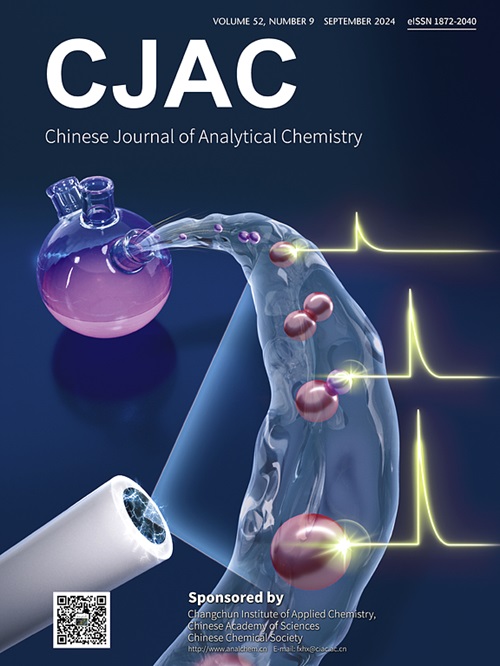解密桑菊饮改善急性肺损伤的机制:包含化学成分分析、网络药理学、代谢组学、分子对接和分子生物学的综合系统药理学方法
IF 1.3
4区 化学
Q4 CHEMISTRY, ANALYTICAL
引用次数: 0
摘要
桑菊饮是一种著名的中药配方,在急性肺损伤(ALI)治疗中得到广泛应用。然而,其潜在的治疗机制仍然不清楚。本研究设计了一种创新的综合方法,将先进的化学分析与生物分析相结合,以阐明SJY在ALI治疗中的作用机制。初步采用UFLC-ESI-QTOF-MS对SJY的化学成分进行了精确分析。随后,网络药理学预测了SJY有益作用的潜在靶点和信号通路。同时对ALI大鼠进行药效学评价。利用LC-MS和1H NMR代谢组学技术以及创新的数据融合策略,确定了潜在的生物标志物和受干扰的代谢途径。至关重要的是,整合网络药理学和代谢组学的见解产生了对机制的整体理解。最后进行分子对接、Western Blot、qRT-PCR验证实验。值得注意的是,SJY抗ali活性的潜在关键生物活性成分包括芹菜素。给药后,花生四烯酸(AA)代谢和PI3K-Akt通路等代表性通路受到明显干扰。此外,综合数据强调PTGS2、PLA2和AA代谢是关键,将ALI治疗中SJY的预测靶点和代谢改变联系起来。总之,本研究揭示了SJY在ALI治疗中的机制,提出了一个先进的跨学科框架。它加深了我们对中药在急性肝损伤中的作用的理解,为化学-药理学界面的研究树立了新的标准。本文章由计算机程序翻译,如有差异,请以英文原文为准。

Deciphering the mechanism of Sang Ju Yin in ameliorating acute lung injury: An integrated systems pharmacology approach encompassing chemical composition analysis, network pharmacology, metabolomics, molecular docking and molecular biology
Sang Ju Yin (SJY), a renowned traditional Chinese medicinal formula, has been widely utilized in acute lung injury (ALI) management. Yet, its underlying therapeutic mechanisms remain obscure. This study devised an innovative and integrated methodology, merging advanced chemical analysis with biological assays, to elucidate SJY's action mechanism in ALI treatment. Initially, UFLC-ESI-QTOF-MS was employed to precisely analyze SJY's chemical constituents. Subsequently, network pharmacology predicted potential targets and signaling pathways for SJY's beneficial effects. In parallel, pharmacodynamic evaluation was performed on ALI rats. Utilizing LC-MS and 1H NMR metabolomics techniques with an innovative data fusion strategy, potential biomarkers and perturbed metabolic pathways were identified. Crucially, integrating network pharmacology and metabolomics insights yielded a holistic understanding of the mechanism. Finally, verification experiments involving molecular docking, Western Blot, and qRT-PCR were carried out. Notably, potential key bioactive components including apigenin were identified for SJY's anti-ALI activity. Marked perturbations in representative pathways such as arachidonic acid (AA) metabolism and PI3K-Akt pathway were obtained after SJY administration. Furthermore, integrated data spotlighted PTGS2, PLA2, and AA metabolism as pivotal, linking predicted targets and metabolic alterations for SJY in ALI treatment. In summary, this study uncovers SJY's mechanism in ALI treatment, presenting an advanced interdisciplinary framework. It deepens our comprehension of traditional Chinese medicine's role in ALI, setting a new standard for research at the chemistry-pharmacology interface.
求助全文
通过发布文献求助,成功后即可免费获取论文全文。
去求助
来源期刊
CiteScore
3.60
自引率
25.00%
发文量
17223
审稿时长
35 days
期刊介绍:
Chinese Journal of Analytical Chemistry(CJAC) is an academic journal of analytical chemistry established in 1972 and sponsored by the Chinese Chemical Society and Changchun Institute of Applied Chemistry, Chinese Academy of Sciences. Its objectives are to report the original scientific research achievements and review the recent development of analytical chemistry in all areas. The journal sets up 5 columns including Research Papers, Research Notes, Experimental Technique and Instrument, Review and Progress and Summary Accounts. The journal published monthly in Chinese language. A detailed abstract, keywords and the titles of figures and tables are provided in English, except column of Summary Accounts. Prof. Wang Erkang, an outstanding analytical chemist, academician of Chinese Academy of Sciences & Third World Academy of Sciences, holds the post of the Editor-in-chief.

 求助内容:
求助内容: 应助结果提醒方式:
应助结果提醒方式:


